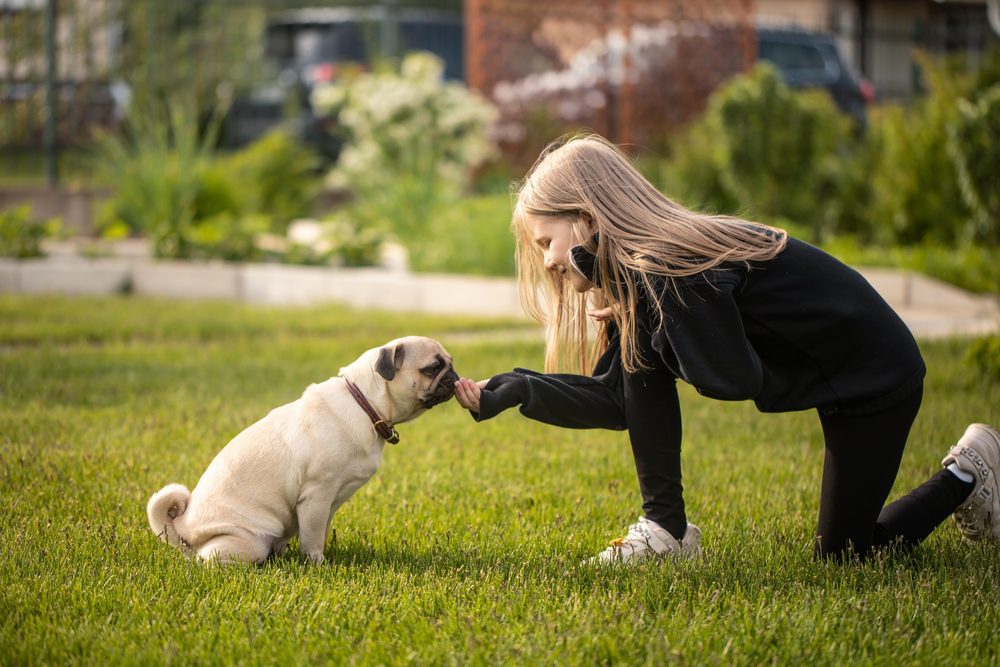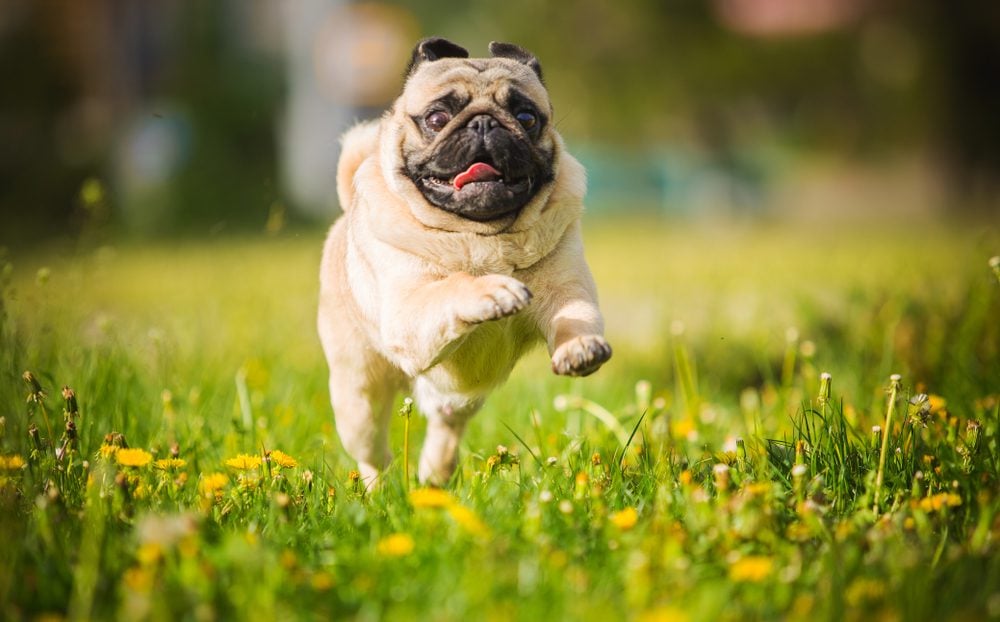With how adorably cute pugs are at everything they do, it’s hard to think of something they can’t do! It’s when you need to consider making them your service dog that things become a bit complicated.
The process of getting a service dog may seem a bit overwhelming, but you’ll find that it’s actually quite easy once you know what you need to do.
The good news is that pugs can be service dogs, but there are certain things that you must be aware of, and we’re going to explain those things right here in this article.
What Defines a Service Dog?
It’s important to understand what service dogs really are, what they do, and what requirements they need to meet in order to become one.
They’re trained to help people with disabilities in amazing ways. These ways can vary widely depending on the disability but may include guiding individuals with visual impairments, alerting those with hearing impairments to sounds, providing stability and balance for those with mobility impairments, and even detecting medical emergencies such as seizures or low blood sugar levels.
What makes service dogs special is that they’re not just regular pets. In many countries, including the United States, service dogs are protected by laws such as the Americans with Disabilities Act (ADA). They have special rights in the law, like access to public places such as stores, restaurants, and public transportation, where pets would typically be prohibited. This helps people with disabilities a lot.
These dogs are also always on their best behavior because that’s just how they’ve been trained. These dogs undergo extensive training to be well-behaved, obedient, and non-aggressive. They are trained to remain calm and focused, even in challenging situations, to ensure the safety and comfort of their handlers. This is really important to keep everyone safe.
It’s not just the training that makes them special; it’s also the special bond they share with their owners. Service dogs often develop a deep connection with their owners, providing emotional support and companionship in addition to their practical assistance.
This bond is a vital part of the service dog-handler relationship and contributes to the overall well-being of people with disabilities.
In simple words, a service dog is a fantastic, well-trained friend who helps people with disabilities and has some special rights because of its important job.
Why Are Pugs Good Service Dogs?
There’s a lot of reasons to love pugs, and pretty much all of them are part of why they make such good therapy dogs! All dog breeds have characteristics that make them really good at some things but not so good at others. In the case of pugs, these are the things that make them really good at being a service dog:
1. They Can Be Trained
Pugs are known to be really playful and affectionate with pretty much everyone, and while they may have a reputation for being a bit stubborn, they can absolutely be trained.
Like most dogs, pugs respond well to positive reinforcement training methods, which involve rewarding them for good behavior with treats, praise, or toys. With patience, consistency, and a lot of love, pugs can learn basic commands, house training, and even more advanced tricks.
While they may have their own eccentric little personalities, pugs can certainly become well-behaved and obedient companions with the right training and dedication from their owners.
2. They’re Good With Kids
Pugs are definitely the definition of a “gentle giant” when it comes to their interactions with kids. They’re pretty well known for their friendly and affectionate nature, making them excellent companions for children.
Pugs are also typically very patient and tolerant, which means they can handle the energy and curiosity of kids quite well. They love to play and enjoy being part of family activities, and their small size also makes them less intimidating for children, so they become their favorite playmates!



Their loving disposition often leads to strong bonds between pugs and kids. Just remember that you will need to supervise any interactions between dogs and children to ensure both are safe and comfortable in each other’s presence.
3. They Don’t Scare People
It’s no secret that your pug has a charming and approachable appearance that tends to put people at ease. Their cute, wrinkled faces and big, expressive eyes often make them seem more like stuffed animals than intimidating dogs.
This gentle and non-threatening appearance can help pugs not to scare or intimidate people, especially those who may be nervous around dogs or have had negative experiences with larger or more imposing breeds.
Pugs’ friendly and sociable personalities further contribute to their reputation as dogs that are less likely to instill fear in others. However, it’s essential to remember that individual dogs may vary in behavior, so responsible ownership and proper training are still vital to ensure any dog, including pugs, behaves well in various situations.
4. They’re Loving and Lovable
They truly are loving and lovable dogs. Their affectionate nature is one of their best qualities. Not only do they have a special knack for forming deep emotional bonds with their owners, but they also actually crave human attention and companionship.
Pugs are known for their gentle and warm-hearted disposition, making them incredibly easy to love in return. Their willingness to snuggle up, wag their curly tails, and give sweet, slobbery kisses makes them irresistible to many people.
Whether you’re feeling down and need comfort or just want some extra love, pugs are always there with their loyal and loving hearts, ready to brighten your day along with anyone else who might be nearby!
How Can I Make My Pug a Service Dog?
Now that you understand why your pup can be the service dog of your dreams, you’re probably looking for the step-by-step process to getting them an Emotional Service Animal letter.
Well, before you get to that part, there are a few things you’ll need to make sure of so you and your dog have the best chance of success.
Find Out Whether Your Pug Is Right for the Job
The first and most important step in making your pug a service dog is to assess their suitability for the role you want them to play. Not all pugs are cut out to be service dogs, as it requires a specific temperament and disposition.
Think of it as military service; no matter how enthusiastic someone is, there are some jobs they just physically won’t be able to perform as required.
Service dogs need to be calm, well-behaved, and able to focus on their tasks even in distracting environments, which they’re going to be in frequently. Additionally, they should be comfortable around people and not display aggression or excessive fear – both could cause a problem for you and the people around you.
Your pug should also be physically healthy and able to handle the demands of service work. They don’t need to be able to do everything a German Shepherd does, but they also can’t be ‘unfit by pug standards.’
If you’re confused about this or don’t think you can effectively assess your dog on your own, that’s perfectly fine! Consulting with a professional dog trainer or a service dog organization can help you evaluate your pug’s potential as a service dog while also taking the stress off your shoulders in the process. Plus, you can be certain that their verdict will be reliable.
Train Them for the Canine Good Citizen Test
Another important part of preparing your pug for service work is to ensure they have a solid foundation in basic obedience and manners – key to ensuring appropriate behavior in public. The Canine Good Citizen (CGC) test is an excellent benchmark for this. It’s a test you’ll need your pug to pass in order to be a service dog. It basically evaluates your dog’s behavior and training in various real-life situations, and to pass the CGC test, you’ll need to teach your pug the following commands and skills:
- Basic Obedience: Start by teaching your pug basic commands like sit, stay, and come. These serve as the building blocks of good behavior.
- Walking Nicely: Teach your pug to walk on a leash without pulling you all over the place, something that’s especially important when you go out together.
- Being Polite: Make sure your pug knows how to be polite around people and other dogs. They should not jump on people or get aggressive around other dogs (or people!).
- Handling and Touch: Get your pug used to being touched and handled by different people. This helps them stay calm in various situations, such as on a crowded bus or metro.
- No Fear or Aggression: Your pug should not be scared or angry when they meet new people or go to new places.
- Passing a Special Test: Make sure your pug passes the Canine Good Citizen (CGC) test, which is essentially like getting a gold star for good behavior in the world of pets.
- Practice, Patience, and Praise: Train your pug with practice. Be patient if they make mistakes, and give them praise and treats when they do well. This makes learning fun for them.



Move Onto the Certification Process
Once your pug has passed the CGC test and has the necessary skills and behavior, the next step is to get them certified as a service dog. This involves obtaining the required documentation to prove that your pug is indeed a service dog.
While there is no official certification process or registry for service dogs in many countries, including the United States, you will need a letter from a licensed healthcare professional (such as a doctor or therapist).
This letter will state that you have a disability and your pug is a necessary part of your treatment plan. This letter, along with a CGC certificate, will help establish your pug’s status as a service dog in case anyone asks or wants to verify.
Keep in mind that service dogs do not require specialized ID cards or vests, but if you can carry them, they’ll be quite helpful in showing authorities that your pug is a working dog.
So Can Pugs Be Service Dogs?
The answer is a resounding yes – pugs can absolutely be service dogs! The process can be lengthy, sure, and you’ll definitely need to make sure your pug can actually go through it with you before you begin, but once you do – it opens a world of possibilities.
As your service dog, it can travel with you, be in public places, and pretty much stay by your side forever.
